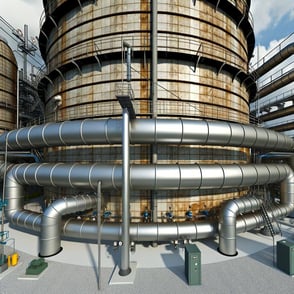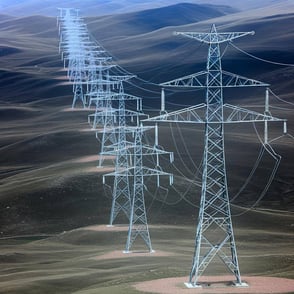Solar Energy Generation
Photovoltaic plants convert sunlight into electricity using solar panels. They offer a clean, renewable energy source, reduce emissions, and are increasingly cost-effective.
What are Photovoltaic Plants?
Photovoltaic plants (PV plants) are facilities that convert sunlight directly into electricity using semiconductor materials through a process known as the photovoltaic effect. This process occurs when certain materials absorb photons (light particles) and release electrons, generating an electric current. Solar energy is a type of renewable and inexhaustible energy source, as it harnesses energy from the sun, which is abundant and continuously replenished. The same as wind, hydro, and nuclear energy generation, photovoltaic plants produce electricity without emitting greenhouse gases, making them an environmentally friendly option. PV plants can vary in size and application, ranging from small self-consumption systems installed on residential rooftops to large-scale solar farms that supply power to the electrical grid. This versatility allows photovoltaic technology to be implemented in diverse settings, contributing significantly to global efforts to reduce carbon emissions and combat climate change.
How Photovoltaic Electricity Generation Works
Photovoltaic plants generate electricity through solar panels composed of multiple solar cells. PV plants primarily use solar cells made from materials like monocrystalline, polycrystalline, or amorphous silicon. Monocrystalline silicon cells achieve the highest efficiency, but are also the most expensive. Similarly, amorphous silicon cells provide the lowest efficiency, but are also the least expensive. These cells capture sunlight and convert it into direct current (DC) electricity.
There are two main types of PV installations: grid-connected and off-grid. Grid-connected systems are divided into photovoltaic power plants, which feed all produced energy into the grid, and self-consumption generators, which use some of the produced energy on-site and feed any excess into the grid. These systems consist of photovoltaic panels, inverters, and transformers. The panels capture solar radiation, the inverters convert DC to alternating current (AC) suitable for use in self-consumption and for feeding into the power grid, and the transformers increase the voltage to a level suitable for the grid.
Off-grid systems, often used in remote areas, operate independently from the grid as the name suggests. These systems require batteries to store excess energy produced during sunny periods and controllers which protect the batteries from overcharging and ensure efficient use. This stored energy can then be used during periods without sunlight, ensuring a continuous power supply.

The Impact of Photovoltaic Plants on the Energy Sector
Photovoltaic plants have a significant positive impact on the energy sector by providing a clean, renewable source of electricity that reduces reliance on fossil fuels. PV systems help lower greenhouse gas emissions, contributing to the fight against climate change. The modular nature of PV systems allows for a wide range of applications, from large solar farms to small rooftop installations, making them versatile and scalable.
PV technology also supports the development of sustainable energy infrastructure, particularly in rural or isolated areas where traditional power lines are not feasible. By enabling energy independence and resilience, PV plants enhance energy security and reduce the risk associated with energy imports. The integration of energy storage solutions with PV systems further improves reliability by storing excess electricity for later use.
Economically, the adoption of PV technology stimulates job creation in manufacturing, installation, and maintenance sectors, fostering green jobs and boosting local economies. Additionally, the increasing efficiency and declining costs of PV technology continue to make it a competitive and attractive option for energy generation. As more PV plants come online, they contribute to reducing electricity prices by increasing the supply of low-cost renewable energy, which can lower overall market prices and provide cost savings for consumers and businesses. This effect can be observed in the merit order of the Day-Ahead Market. This economic benefit further accelerates the transition towards a more sustainable and resilient energy future.
Conclusion
Photovoltaic plants represent a transformative advancement in renewable energy technology, offering a sustainable and environmentally friendly way to generate electricity. By converting sunlight into usable power, PV systems reduce greenhouse gas emissions, enhance energy security, and contribute to economic growth.
As technology continues to improve and costs decline, photovoltaic plants are poised to play an increasingly significant role in the global energy landscape, driving the transition towards a cleaner and more sustainable future.
Glossary
- Photovoltaic Effect: The process by which sunlight is converted into electricity using semiconductor materials.
- Solar Cells: Semiconductor devices that convert sunlight into electricity, typically made from silicon.
- Module: A collection of solar cells connected together, also known as a solar panel.
- Array: A group of solar modules connected together to increase the amount of electricity generated.
- Inverter: A device that converts direct current (DC) electricity produced by solar cells into alternating current (AC) electricity.
- Monocrystalline Silicon: Solar cells made from a single crystal of pure silicon, known for high efficiency.
- Polycrystalline Silicon: Solar cells made from multiple silicon crystals, offering a balance between cost and efficiency.
- Amorphous Silicon: Solar cells with a disordered crystalline structure, providing lower efficiency but at a lower cost.
- Energy Storage: Technologies, such as batteries, used to store excess electricity generated by PV systems for use when sunlight is not available.
.png?width=200&height=80&name=etpa-logo-color%20(1).png)































.png)
.png)
-1.png?width=250&height=100&name=etpa-logo-color%20(1)-1.png)